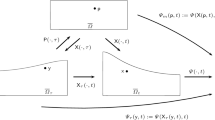Abstract
In the present paper, a formulation of Lagrange’s equations, written in the framework of the Lagrange (material) description of Continuum Mechanics, is provided for open systems. An open system is constituted by (the portion of) a continuous material body that is enclosed by a nonmaterial surface. Such a surface, through which a flow of mass takes place, is also denoted as a control surface, and the corresponding volume is called a control volume. In order to apply Lagrange’s equations of analytical mechanics, the motion and the deformation of the body is modeled in the framework of the Ritz approximation technique by means of a finite number of generalized coordinates. However, since mass may not be conserved in an open system due to the flow of mass through the control surface, the original form of Lagrange’s equations must be accomplished by proper flux terms to be considered at the control surface. In order to derive this extended form, a local version of Lagrange’s equations is derived first, using a proper mathematical manipulation of the local relation of balance of linear momentum written in the Lagrange description of Continuum Mechanics. This local form is integrated over the volume that instantaneously is enclosed by the image of the control surface in a properly chosen reference configuration. In the integrated form, the Truesdell–Toupin method of fictitious particles and generalized Reynolds transport theorems are utilized in order to exchange the integrals and the partial derivatives with respect to time and generalized coordinates and velocities. This yields the desired form of Lagrange’s equations for open systems, written in the Lagrange description of Continuum Mechanics. Illustrative examples demonstrate the consistence of this novel form with the Euler (spatial) version of Lagrange’s equations for open systems, which was derived earlier by the present authors.
Similar content being viewed by others
References
Dugas R.: A History of Mechanics. Dover, New York (1988)
Casey J.: Geometrical derivation of Lagrange’s equations for a system of particles. Am. J. Phys. 62, 836–847 (1994)
Shabana A.A.: Dynamics of Multibody Systems, 3rd edn. Cambridge University Press, Cambridge (2005)
Gignoux C., Silvestre-Brac B.: Solved Problems in Lagrangian and Hamiltonian Mechanics. Springer, Dordrecht (2009)
Ziegler F.: Mechanics of Solids and Fluids, 2nd edn, 2nd print. Springer, New York (1998)
Leissa A.W.: The historical bases of the Rayleigh and Rayleigh–Ritz methods. J. Sound Vib. 287, 961–978 (2005)
Goldstein H., Poole Ch., Safko J.: Classical Mechanics, 3rd edn. Addison Wesley, San Francisco (2002)
Washizu K.: Variational Methods in Elasticity and Plasticity, 2nd edn. Pergamon Press, Oxford (1974)
Truesdell, C., Toupin, R.A.: The classical field theories. In: Flügge, S. (ed.) Handbuch der Physik, vol. II/l: Prinzipien der klassischen Mechanik und Feldtheorie, pp. 226–793. Springer, Berlin (1960)
Irschik, H., Holl, H. J., Hammelmüller, F.: The Rayleigh–Ritz technique and the Lagrange equations in Continuum Mechanics: formulations for material and non-material volumes. In: Irschik, H., Schlacher, K. (eds.) Advanced Dynamics and Control of Structures and Machines, CISM Courses and Lectures, vol. 444, pp. 21–36. Springer, Wien, New York (2004)
Irschik H., Holl H.J.: Mechanics of variable-mass systems—Part 1: balance of mass and linear momentum. ASME Appl. Mech. Rev. 57, 145–160 (2004)
Cveticanin L.: Dynamics of Machines with Variable Mass. Gordon and Breach Science, London (1998)
Mušicki D.: General energy change law for systems with variable mass. Eur. J. Mech. A/Solids 18, 719–730 (1999)
Cveticanin L.: Conservation laws in systems with variable mass. ASME J. Appl. Mech. 60, 954–959 (1993)
Pesce C.P.: The application of Lagrange equations to mechanical systems with mass explicitly dependent on position. ASME J. Appl. Mech. 70, 751–756 (2003)
Pesce C.P., Tannuri E.A., Casetta L.: The Lagrange equations for systems with mass varying explicitly with position: some applications to offshore engineering. J. Braz. Soc. Mech. Sci. Eng. 28, 496–504 (2006)
Irschik H., Holl H.J.: Lagrange’s equations written for a non-material volume. Acta Mech. 153, 231–248 (2002)
Irschik, H., Holl, H.J.: On Langrange’s equations for open systems. In: Beskos, D.E., Stavroulakis, G.E. (eds.) CD-Rom Proceedings 10th HSTAM International Congress on Mechanics 2013, Chania, Crete, Greece, 25–27 May 2013, Invited Plenary Lecture (2013)
Ziegler F.: Didaktische Aspekte in mechanischen Erhaltungssätzen. GAMM-Mitteilungen 21, 61–72 (1998)
Stangl M., Gerstmayr J., Irschik H.: An alternative approach for the analysis of non-linear vibrations of pipes conveying fluid. J. Sound Vib. 310, 493–511 (2008)
Stangl M., Gerstmayr J., Irschik H.: A large deformation planar finite element for pipes conveying fluid based on the absolute nodal coordinate formulation. ASME J. Comput. Nonlinear Dyn. 4, 0310091–0310098 (2009)
Païdoussis, M.P.: Fluid–structure interactions: slender structures and axial flow, vol. 1. Academic Press, London (1998), 2nd edn (2013)
Ghayesh M.H., Païdoussis M.P., Amabili M.: Nonlinear dynamics of cantilevered extensible pipes conveying fluid. J. Sound Vib. 332, 6405–6418 (2013)
Irschik H.: On rational treatments of the general laws of balance and jump, with emphasis on configurational formulations. Acta Mech. 194, 11–32 (2007)
Casey J.: A basic power decomposition in Lagrangian mechanics. ASME J. Appl. Mech. 71, 735–738 (2004)
Casetta L., Pesce C.P.: On Seliger and Whitham’s variational principle from the point of view of open hydrodynamic systems. Acta Mech. 219, 181–184 (2011)
Author information
Authors and Affiliations
Corresponding author
Rights and permissions
About this article
Cite this article
Irschik, H., Holl, H.J. Lagrange’s equations for open systems, derived via the method of fictitious particles, and written in the Lagrange description of continuum mechanics. Acta Mech 226, 63–79 (2015). https://doi.org/10.1007/s00707-014-1147-8
Received:
Revised:
Published:
Issue Date:
DOI: https://doi.org/10.1007/s00707-014-1147-8




